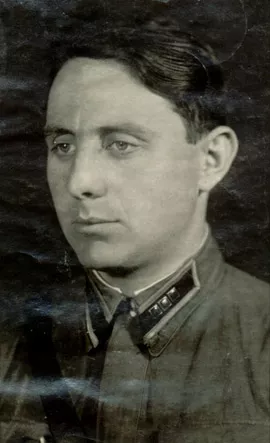This is me after returning from the rear of the enemy near Smolensk where I was a radio operator. I was sent there on 19th April 1942, and returned on 8th May 1942. I was photographed by our headquarters' photographer. I was eager to send my family this photograph, but I did not know their address. This photo was taken in 1942.
In 1940 I entered to the Military Electrotechnical Academy of Communication in Leningrad. In June 1941 I finished my first academic year in the Academy. June 22nd 1941 the Great Patriotic War began. Then there was an order to form the 11th special infantry brigade from cadets issued. I was appointed commanding officer of a squad. I started training my subordinates self-defense methods, when we received another order. It stated that all Academy cadets had to go back to Leningrad. When our replacement forces arrived, I transferred command to another lieutenant and we went back to Leningrad to continue our studies. And then the siege of Leningrad began. Then we got an order for the Academy to relocate to Tomsk. The planes delivering food products to Leningrad transported us from Leningrad. After two months in Tomsk we were notified that we would have an accelerated graduation to have the right to finish the Academy after the war. I was one of the first 5 graduates of the Academy. In March 1942 we were awarded the rank of lieutenants and took a train to Moscow to the Communication Headquarters of the army.
In March 1942 we were awarded the rank of lieutenants and took a train to Moscow to the Communication Headquarters of the army. I was assigned to the 99th Guard tank brigade as communication commanding officer. I was appointed the chief of the radio center of the Air Force headquarters located in Moscow. My subordinates were the girls, who volunteered to be radio operators. We received ciphered cables and I submitted them to the headquarters. One month later the radio operator of the 4th Air Force Corps deployed in the German rear near Smolensk perished from an antipersonnel mine. I agreed to go there instead of him. I took a plane with two soldiers. We flew at night. In landing troops their commander is person number one, and number two is the radio operator receiving directions of the headquarters and hands them to the commander. These were ciphered messages and I was the only person, who knew the content. The deployment of our landing troops in the German rear was very dangerous for them. Our 6 brigades were well-trained paratroopers, and we caused severe damages in the enemy’s rear. On 6th May 1942 I received another cipher message from Moscow. It was a direction for us to leave the site of our deployment. My brigade and I relocated to Ramenskoye. I was sent to Teykovo town where I was appointed communication chief of the 4th maneuver airborne landing brigade. I had to train radio operators. I arrived at the brigade in the rank of captain, and I was appointed assistant chief of communication of the brigade.
The 4th maneuver airborne landing brigade and the 6th brigade were merged to form the 10th guard airborne landing brigade. After it recaptured Krivoy Rog was awarded the name of the Krivoy Rog Red Banner Airborne Landing Division, but then we were on the front-line in the north making efforts to recapture Staraya Russa. There were long and hard fights near Staraya Russa, and we had to retreat incurring losses. I lost many friends there. We almost lost the division. There were just few survivors.
The remains of our division relocated to Kharkov for remanning. There were 7 echelon trains with 5 of them transporting cannons. After remanning and reequipment near Kharkov we were sent to cross the Dnieper River in October 1943. The splinter injured my head. After crossing the Dnieper we moved in the direction of Krivoy Rog. That was when I was awarded the first Order of the Red Combat Banner for being wounded, but staying in the formation. I always stood beside my division commander. We developed good relationships. In December 1943 we started preparations for our attack on Krivoy Rog. We liberated Krivoy Rog by 23rd February 1944, the Soviet Army Day. I was awarded a II Grade Order of the Great Patriotic War for my participation in the liberation of Krivoy Rog.


















